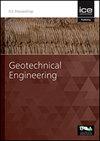Significance of three-dimensional analyses on static and seismic stability analyses of fractured open-pit mine slopes
IF 1.7
4区 工程技术
Q3 ENGINEERING, GEOLOGICAL
Proceedings of the Institution of Civil Engineers-Geotechnical Engineering
Pub Date : 2022-08-30
DOI:10.1680/jgeen.21.00030
引用次数: 0
Abstract
Most studies on open-pit mine stability have been performed in the two-dimensional (2-D) mode which neglected the effect of the circular shape and thus the effect of third direction boundary conditions. This paper aims to study the effect of the third dimension in static and dynamic stability analyses of pit slopes, comparing results from 2-D and 3-D numerical and limit equilibrium analyses. The geomechanical data from Choghart open pit mine located in the seismically active area in central Iran is considered, under a historical earthquake (Mw=6.4). Kinematic analyses showed that two tectonic blocks of the mine namely, BL1 and BL2 are susceptive to wedge and planar failures, respectively. From the 2-D and 3-D static analyses, both blocks are stable with higher safety factors for numerical 3-D analyses. For dynamic analyses, unlike BL1 where both 2-D and 3-D analyses showed wedge instability, for BL2 the 2-D numerical analyses showed instability, whereas the 3-D numerical and pseudo-static analyses indicated the block stability. The results revealed that the 3-D safety factors are generally 20 to 40 percent greater than the ones from 2-D analyses. This can be explained by the consideration of the third direction effect, verifying the importance of 3-D analysis.三维分析对破碎露天矿边坡静力及地震稳定性分析的意义
露天矿稳定性研究大多采用二维(2-D)模式,忽略了圆形状的影响,从而忽略了第三方向边界条件的影响。本文旨在研究三维在基坑边坡静、动稳定分析中的作用,比较二维和三维数值及极限平衡分析的结果。本文考虑了位于伊朗中部地震活跃区的Choghart露天矿在一次历史地震(Mw=6.4)下的地质力学数据。运动学分析表明,该矿BL1和BL2两个构造块体分别易发生楔形破坏和平面破坏。从二维和三维静力分析来看,两个块体都是稳定的,具有较高的三维数值分析安全系数。在动力分析中,与BL1的二维和三维分析均显示楔形失稳不同,BL2的二维数值分析显示失稳,而三维数值和拟静力分析显示块体稳定。结果表明,三维安全系数一般比二维安全系数高20% ~ 40%。这可以通过考虑第三方向效应来解释,验证了三维分析的重要性。
本文章由计算机程序翻译,如有差异,请以英文原文为准。
求助全文
约1分钟内获得全文
求助全文
来源期刊
CiteScore
4.40
自引率
4.50%
发文量
68
审稿时长
3 months
期刊介绍:
Geotechnical Engineering provides a forum for the publication of high quality, topical and relevant technical papers covering all aspects of geotechnical research, design, construction and performance. The journal aims to be of interest to those civil, structural or geotechnical engineering practitioners wishing to develop a greater understanding of the influence of geotechnics on the built environment.

 求助内容:
求助内容: 应助结果提醒方式:
应助结果提醒方式:


